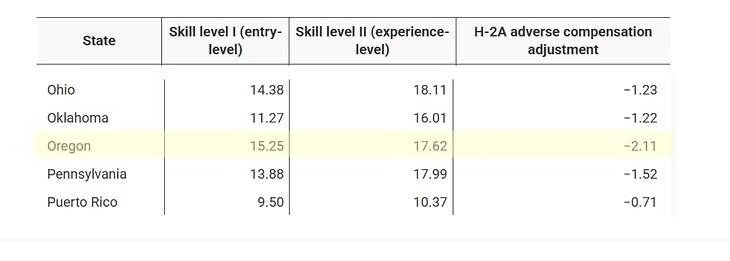 [5]
[5]
By Oregon Farm Bureau [6],
The U.S. Department of Labor announced significant, positive changes to federal H-2A policy. While the details for what this means for Oregon’s farmers are still being ironed out, a few things are clear – namely that it is strange to hear “good news” and “new labor regulations” in the same sentence.
What you should know
First, farmers that use the program will see a significant reduction in the Adverse Effect Wage Rate (AEWR), which formerly resided at $19.82 an hour. The new wage rates are reflected in the chart below.
Current AEWR rates after the implementation of the temporary final rule.
The new rules also apply a $2.11 reduction (called an adverse compensation adjustment) to these new rates to offset the benefit of housing provided to workers. This further reduces hourly wages for Skill I (entry-level positions) to $13.14/hour and for Skill II (experience level positions) to $15.51/hour.
The H-2A wage rate will always be the highest applicable wage between federal minimum wage, state minimum wage, and the AEWR. Oregon is unique as there are several different tiers for minimum wage.
Oregon’s 2025 minimum wage tiers.
This temporary final rule would likely move the AEWR rate below Oregon’s minimum wage in some cases, making minimum wage the highest applicable wage for growers. After preliminary calculations, this change could save producers that use the program up to 20% in labor costs.
It is also important to note that these rules only apply to contracts signed AFTER the release of the temporary rule on October 2, 2025.
Oregon Farm Bureau would like to thank the Trump administration and U.S. Secretary of Labor Lori Chavez-DeRemer for implementing these important changes to H-2A policy to rectify an unsustainable situation for farmers who use the program.
The Secretary’s background working with the Oregon Farm Bureau and her experience on the House Ag Committee as a member of the Ag Labor Working group positioned her well to understand the impacts this rule has on agriculture. Labor costs can be nearly half the cost of production, making it hard for family farmers to break even and more expensive to grow food domestically. Higher production costs, including through regulatory hurdles and administrative requirements, can ultimately lead to more dependence on imported foods, especially for labor-intensive crops. Oregon is a specialty crop state and will benefit greatly from this change.

